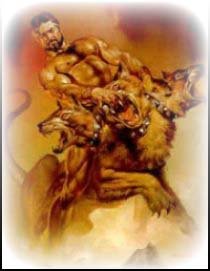|
|
- A US Customs Labrador named "Snag" has made 118 drug seizures worth a canine record $810 million. The greatest number of drug seizures by dogs is 969 in 1988. IN ONE YEAR! The team of "Rocky" and "Barco" patrolled the Texas and Mexico border, alias "Cocaine Alley." They were so good that Mexican drug lords put a price of $30,000 dollars on their heads.

Read more!



- All dogs, from the German Shepherd to the tiny Poodle, are direct descendants of wolves. They can all breed together and produce fertile offspring. Technically they are of the same species.
- Dogs can very easily regurgitate. In fact, after eating wolves can travel significant distances back to their dens and regurgitate the food at will to feed their pups!
- Canis Major or The Great Dog:- The great dog follows his master, Orion, as he makes his annual journey through the sky. Sirius, also known as the Dog Star, is located on the shoulder of Canis Major. It is the brightest in the heavens, and its name means sparkling and scorching, as it is nearest to the sun during the height of summer.
- Argos or Argus, Ulysses' hunting dog, was the only creature to recognize the Greek hero when he returned home disguised as a beggar after 20 years of adventure.
- Cerberus, the three-headed dog of Greek mythology, guarded the gates to the underworld.

- Laika became the world's first space traveler. Russian scientists sent the small animal aloft in an artificial earth satellite in 1957.

- The basenji, an African wolf dog, is the only dog that cannot bark. A hound breed, the basenji is not entirely mute and is characterized by its wrinkled forehead and tightly curled tail.

- Dogs (and wolves and foxes) are descended from a small, weasel-like mammal called Miacis which was a tree-dwelling creature and existed about 40 million years ago. Dogs, as we know them today, first appeared in Eurasia about 13,000 years ago, and were probably a direct descendant of a small, grey wolf . The dingo is not native to Australia but was introduced thousands of years ago by the first immigrants. Dogs were first domesticated by cavemen in the Palaeolithic age and gradually developed (or were bred) into the breeds known today.
- Many foot disorders in dogs are related to long toenails. Check your dog's nails once a month and trim when necessary, avoiding the vein.
- Sadly, statistics indicate that eight million pets lose their lives in animal shelters each year due to overpopulation.
- In America, about one family in three owns a dog.
- The average dog lives 8 to 15 years.
- People have been keeping dogs as pets for the past 12,000 years.
- Put your kitchen garbage can in a cupboard. It's the only way to be certain your dog will stay out of it.
- To keep your dog off the couch, nail empty tuna cans to a board and put it there before leaving. Your dog will find it uncomfortable, and it's easy to store under the couch.
- Even after your dog is old enough to be fed only once a day, he should be given a morning snack just to calm his rumbling tummy.
- There's no such thing as a dumb dog; after all, while we're out working all day, they're home sleeping.
- A dog needs to work off excess energy every day.
- Mixed-breed dogs usually have behavioral traits similar to the breed they most resemble in appearance.
- Dogs that chase cars have learned that cars run away. This behavior is reinforced each time he chases one away.
- Never wake a sleeping dog by poking or shaking it.
- If you're finding it difficult to teach your dog to catch a ball, try tossing something soft like a knotted piece of fabric instead. Some dogs find softer items easier to catch.
- Anyone who says he works like a dog obviously doesn't own one.
- Dogs and cats turn in circles before lying down because in the wild this instinctive action turns long grass into a bed.
- People with more than one dog shouldn't try to trat them all as equals. Because pack position is important to a dog, this only encourages jealousy games.
- You don't have to put up with your dog destroying flower beds or digging up the yard; simply fence off a separate section just for him.
- A one-year-old dog is physically as mature as a 15 year-old human.
- Dogs' internal clocks are really magnificent. They know when it's time for you to arrive home, feed them, or go to bed if you are normally on a schedule.
- Brush your dog 3 times a week in the spring, and you'll have a summer free from shedding.
- If someone in your household is allergic to dogs, bathe your dog every week. He will shed less dry skin. You can also add a teaspoon of cooking oil to your dog's dinner.
- When a dog bays at the moon, it is following a basic urge to call the pack together.
- Rituals are a basic part of canine behavior. Greeting, feeding, hunting and sleeping all include social performances.
- The burying of bones is part of a dog's instinctive feeding ritual; shaking things viciously is part of the hunting ritual.

Dog and Puppy
INTERESTING DOG FACTS
Cool Links
- Funny Games, Videos & Pics
- Funny Dumper
- All Funny Stuff
- Funny Ville
- I-Am-Bored!
- Milk and Cookies
- Dude Help
- Leenks.com
- File Crush





0 Responses to “About dogs - part 3”
Leave a Reply